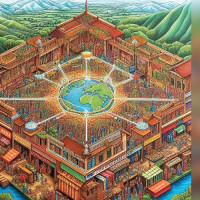- Friday, 20 June 2025
Definitions Limit Human Potential
"To define is to limit." Though Oscar Wilde primarily structured this statement in his infamous “Picture of Dorian Grey”, it knowingly or unknowingly lays the groundwork for many philosophical theories by going beyond just the realms of aestheticism. Wilde, as an aesthete and one of the leaders of the aestheticism movement, worked to dismantle ideologies of conventional beauty, art, and sensory pleasures. Wilde explains how art can exist beyond utility and expectations, and defining art means stripping away its ambiguity, freedom, and essence.
Wilde forges the idea that art does not have to be a reflection of society or lives; it can rather exist without any definition to encapsulate its essence. While Wilde’s work varies in content and premises, his ethos is conveyed distinctively; creation should not be constricted between conventional ideologies. Wilde isn’t the only one who challenges ‘definitions’. Jean-Paul Sartre, through existentialism, questions the notion. In his Being and Nothingness, he introduces the term 'bad faith' (mauvaise foi), which explains how humans deceive themselves to protect themselves from the anxiety that freedom in existence brings. Sartre believed that existence precedes essence. In his belief, putting an essence to existence was to limit the individual from exploring their true nature. In his “Being and Nothingness”, Sartre defined being as being-in-itself (en-soi) and being-for-itself (pour-soi). En-soi works to represent inanimate objects, whereas pour-soi deals with self-aware entities as human beings themselves. However, unlike en-soi, the existence of pour-soi is more fluid, self-aware, and always incomplete. They won’t have a definite shape or purpose. While superficially different, these theories lead us to the same meaning: to define is to limit.
Such thinkers also believed that definitions are an ontological violence to ourselves and our never-ending potential. Thinkers like Heidegger believed that being is never defined; it is constantly unfolding. Such definitions and framings only act as existential reduction.
Martin Heidegger’s Being and Time resurrects the Greek notion of Aletheia (truth as concealment). Heidegger explains how truth is a process and shows us how we perform ontological violence on ourselves by imprisoning us to partial truths. He believes the truth emerges through revealing, allowing beings to show themselves. By definitions, we tend to narrow down the full extent of truth while concealing the point of the truth: objectivity. Heidegger also believed that revealing is an ongoing process and absolute truth can never be reached. But with unconcealment, we can approach the truth and its fluidity closer. This framework helps us rethink how we view and speak of cultural, racial, and sexual identities and how definitions have cost us a lot historically.
To touch a fragment of the varsity of this concept, we can look at how the definitions have caused ontological violence to femininity. Thinkers like Schopenhauer implied that women, as beings, were inferior, confining them to biological and emotional biases. Nietzsche idealised and sensationalised them but simultaneously degraded them as not being in themselves but as an obstacle every man has to go through to reach a certain level of manhood.
These definitions worked as building blocks to misogyny, objectification, and discrimination. To define femininity was to limit women from their freedom, multiplicity, and subjectivity. Simone de Beauvoir’s The Second Sex fundamentally shakes the ground under which such implications were made.
“One is not born, but rather becomes, a woman.”
Through the above statement, she explains how femininity is not innate but created by society under the disguise of biological destiny. Beauvoir breaks down the feminine role and biological and deep psychological analysis in her book to support her statement. Women like Beauvoir attempt to break free of their ontological violence by illuminating the effect of centuries of imposed definition.
But are all definitions bad? Is it possible to function in day-to-day life without some structure?
While it is challenging to integrate it into practice completely, a certain balance can be restored. A person might never be able to function in daily practices by challenging every word, every thought, every interaction, and more they have. The structure should not be abandoned altogether, but it should be viewed as provisional.
In The Birth of Tragedy through the Apollonian/Dionysian Duality, Nietzsche explores similar grounds through two Greek gods: Apollonian and Dionysian. Apollonians abided by logic, convention, and structure, while Dionysians were chaotic and passionate but formless. Nietzsche describes how art, violence, and creation are obtained through the tension between both practices. Staying firm on the Apollonian side constricts growth, innovation, and passion, whereas staying on the Dionysian side can sway you away from your motive and diminish experiences by its reckless nature.
Nietzsche viewed modern developments as increasingly Apollonian, focusing purely on scientific reasonings and structure rather than inspiring the point where the formerly stated developments started – questioning the existing practices.
“To define is to limit” is not a rejection of knowledge but rather an acknowledgement that truth, definitions, beauty, art, and existence are fluid. Our art should always go beyond what convention dictates us to. And the only way to grow is to question our practices.
Had we remained static in one particular way of thinking in the past, we would not have reached where we are. To be human is to know that nothing is absolute and to embrace the anxiety that comes with existential freedom without abandoning it.
(The author is pursuing higher education at Kathmandu University.)















